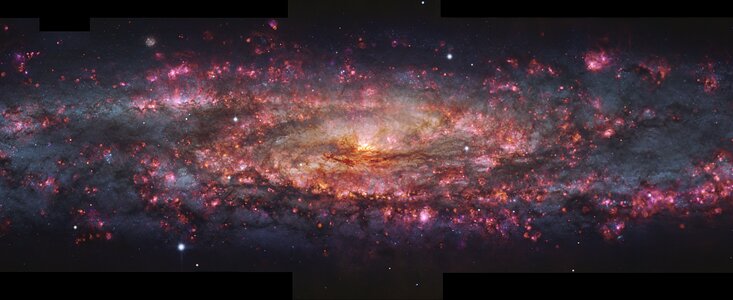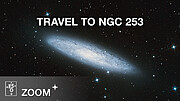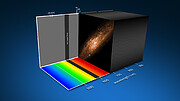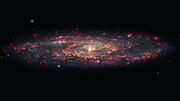Komunikat prasowy
Astronomowie uzyskali najbardziej szczegółowy obraz galaktyki z tysiącami kolorów
18 czerwca 2025
Astronomowie stworzyli galaktyczne arcydzieło: ultraszczegółowy obraz, który ukazuje niewidziane wcześniej cechy Galaktyki Rzeźbiarza. Przy pomocy Bardzo Dużego Teleskopu (VLT), należącego do Europejskiego Obserwatorium Południowego (ESO), obserwowali tę pobliską galaktykę jednocześnie w tysiącach kolorów. Zbierając wielkie ilości danych dla każdej lokalizacji, stworzyli galaktyczny obraz życia gwiazd w Galaktyce Rzeźbiarza.
„Galaktyki to niesamowicie skomplikowane systemy, które nadal próbujemy zrozumieć” mówi Enrico Congiu, badacz z ESO, który kierował nowymi badaniami Galaktyki Rzeźbiarza, opublikowanymi w Astronomy & Astrophysics. Galaktyki są ekstremalnie duże, osiągając rozmiary setek tysięcy lat świetlnych, ale ich ewolucja zależy od tego, co dzieje się w znacznie mniejszych skalach. „Galaktyka Rzeźbiarza znajduje się w idealnym miejscu”, tłumaczy Congiu, “Jest wystarczająco blisko, że możemy rozdzielić jej strukturę wewnętrzną i szczegółowo badać budujące ją cegiełki, ale jednocześnie jest wystarczająco duża, abyśmy mogli nadal widzieć ją jako cały system.
Cegiełki budujące galaktykę – gwiazdy, gaz i pył – emitują światło o różnych kolorach. Dlatego im więcej odcieni kolorów jest na zdjęciu galaktyki, tym więcej możemy dowiedzieć się o tym, jak działa. O ile tradycyjne zdjęcia zawierają jedynie garść kolorów, to nowa mapa Galaktyki Rzeźbiarza ma ich tysiące. Mówi więc astronomom wszystko, czego potrzebują, aby dowiedzieć się o gwiazdach, gazie i pyle wewnątrz niej, na przykład wiek, budowę czy ruch.
W celu utworzenia omawianej mapy Galaktyki Rzeźbiarza, znajdującej się 11 milionów lat świetlnych od nas i znanej także jako NGC 253, badacze obserwowali ją przez ponad 50 godzina przy pomocy instrumentu Multi Unit Spectroscopic Explorer (MUSE) na VLT. Zespół badawczy musiał połączyć ponad 100 ekspozycji, aby pokryć obszar galaktyki o szerokości 65 000 lat świetlnych.
Według współautorki Kathryn Kreckel z Uniwersytetu w Heidelbergu (Niemcy), czyni to mapę potężnym narzędziem: „Możemy ją powiększać, aby badać indywidualne rejony, w których tworzą się gwiazdy, prawie do skali pojedynczych gwiazd, ale możemy także oddalać, aby badać galaktykę jako całość.”
W swoich pierwszych analizach danych, zespół odkrył w tej galaktyce około 500 mgławic planetarnych, czyli obszarów gazu i pyłu odrzucanych przez umierające gwiazdy podobne do Słońca. Współautor Fabian Scheuermann, doktorant na Uniwersytecie w Heidelbergu, wskazuje liczby dla kontekstu: „Poza naszym galaktycznym sąsiedztwem zwykle mamy do czynienia z mniej niż 100 detekcjami na galaktykę.”
Ze względu na własności mgławic planetarnych, mogą one być używane jako znaczniki odległości dla swoich galaktyk macierzystych. „Znalezienie mgławicy planetarnej pozwala nam na weryfikację odległości do galaktyki – krytycznego fragmentu informacji, na którym opierają się badania galaktyki” wyjaśnia Adam Leroy, profesor na Uniwersytecie Stanowym Ohio (USA), współautor badań.
Przyszłe projekty wykorzystujące mapę pozwolą na eksplorację tego, jak przepływa gaz, zmian w jego składzie oraz formowania gwiazd w całej galaktyce. „Nadal zagadką jest, jak takie małe procesy mogą mieć duży wpływ na galaktykę, której cały rozmiar jest tysiące razy większy” mówi Congiu.
Więcej informacji
Wyniki badań zaprezentowano w artykule zaakceptowanym do publikacji w Astronomy & Astrophysics.
Skład zespołu badawczego: E. Congiu (European Southern Observatory, Chile [ESO Chile]), F. Scheuermann (Astronomisches Rechen-Institut, Zentrum für Astronomie der Universität Heidelberg, Germany [ARI-ZAH]), K. Kreckel (ARI-ZAH), A. Leroy (Department of Astronomy and Center for Cosmology and Astroparticle Physics, The Ohio State University [OSU], USA), E. Emsellem (European Southern Observatory, Germany [ESO Garching] and Univ. Lyon, Univ. Lyon1, ENS de Lyon, CNRS, Centre de Recherche Astrophysique de Lyon, France), F. Belfiore (INAF – Osservatorio Astrofisico di Arcetri, Italy), J. Hartke (Finnish Centre for Astronomy with ESO [FINCA] and Tuorla Observatory, Department of Physics and Astronomy [Tuorla], University of Turku, Finland), G. Anand (Space Telescope Science Institute, USA), O. V. Egorov (ARI-ZAH), B. Groves (International Centre for Radio Astronomy Research, University of Western Australia, Australia), T. Kravtsov (Tuorla and FINCA), D. Thilker (Department of Physics and Astronomy, The Johns Hopkins University, USA), C. Tovo (Dipartimento di Fisica e Astronomia ‘G. Galilei’, Universit‘a di Padova, Italy), F. Bigiel (Argelander-Institut für Astronomie, Universität Bonn, Germany), G. A. Blanc (Observatories of the Carnegie Institution for Science, USA, and Departamento de Astronomía, Universidad de Chile, Chile), A. D. Bolatto and S. A. Cronin (Department of Astronomy, University of Maryland, USA), D. A. Dale (Department of Physics and Astronomy, University of Wyoming, USA), R. McClain (OSU), J. E. Méndez-Delgado (Instituto de Astronomía, Universidad Nacional Autónoma de México, Mexico), E. K. Oakes (Department of Physics, University of Connecticut, USA), R. S. Klessen (Universität Heidelberg, Zentrum für Astronomie, Institut für Theoretische Astrophysik and Interdisziplinäres Zentrum für Wissenschaftliches Rechnen, Germany, Center for Astrophysics Harvard & Smithsonian, USA, and Elizabeth S. and Richard M. Cashin Fellow at the Radcliffe Institute for Advanced Studies at Harvard University, USA) E. Schinnerer (Max-Planck-Institut für Astronomie, Germany), T. G. Williams (Sub-department of Astrophysics, Department of Physics, University of Oxford, UK).
Europejskie Obserwatorium Południowe (ESO) umożliwia naukowcom z całego świata na odkrywanie tajemnic Wszechświata z korzyścią dla nas wszystkich. Projektujemy, budujemy i zarządzamy światowej klasy obserwatoriami naziemnymi – których astronomowie używają do odpowiadania na ciekawe pytania i szerzenia fascynacji astronomią – a także promujemy międzynarodową współpracę w astronomii. Ustanowione w 1962 roku jako organizacja międzynarodowa, ESO jest wspierane przez 16 krajów członkowskich (Austria, Belgia, Czechy, Dania, Finlandia, Francja, Hiszpania, Irlandia, Holandia, Niemcy, Polska, Portugalia, Szwajcaria, Szwecja, Wielka Brytania oraz Włochy), a także Chile jako kraj gospodarz, oraz Australię jako strategicznego partnera. Siedziba ESO, a także jego centrum popularyzacji nauki i planetarium (ESO Supernova) znajdują się w pobliżu Monachium w Niemczech, natomiast chilijska pustynia Atakama – niesamowite miejsce z wyjątkowymi warunkami do obserwacji nieba – jest domem dla naszych teleskopów. ESO zarządza trzema lokalizacjami obserwacyjnymi w Chile: La Silla, Paranal i Chajnantor. W Paranal ESO posiada teleskop VLT (Very Large Telescope – Bardzo Duży Teleskop) oraz dwa teleskopy do przeglądów nieba. VISTA pracuje w podczerwieni, VLT Survey Telescope w zakresie widzialnym. W Paranal ESO zarządza także południowym obserwatorium CTA (Cherenkov Telescope Array South) – największym na świecie i najbardziej czułym obserwatorium promieniowania gamma. Wspólnie z międzynarodowymi partnerami ESO zarządza także radioteleskopami APEX i ALMA, które są instrumentami do obserwacji nieba w zakresach milimetrowym i submilimetrowym. Na Cerro Armazones, niedaleko Paranal, budujemy „największe oko świata na niebo”, czyli Ekstremalnie Wielki Teleskop (Extremely Large Telescope, ELT). Nasza działalność w Chile jest zarządzana z biur ESO w Santiago, gdzie współpracujemy też z chilijskimi partnerami.
Linki
- Publikacja naukowa
- Zdjęcia VLT
- Dla dziennikarzy: subscribe to receive our releases under embargo in your language
- Dla naukowców: got a story? Pitch your research
- New ESO analysis confirms severe damage from industrial complex planned near Paranal
Kontakt
Enrico Congiu
European Southern Observatory (ESO)
Santiago, Chile
E-mail: econgiu@eso.org
Kathryn Kreckel
Heidelberg University
Heidelberg, Germany
Tel.: +49 6221 54-1859
E-mail: kathryn.kreckel@uni-heidelberg.de
Adam Leroy
The Ohio State University
Columbus, Ohio, USA
Tel.: +1 614 292-1765
E-mail: leroy.42@osu.edu
Fabian Scheuermann
Heidelberg University
Heidelberg, Germany
E-mail: f.scheuermann@uni-heidelberg.de
Bárbara Ferreira
ESO Media Manager
Germany, Germany
Tel.: +49 89 3200 6670
Tel. kom.: +49 151 241 664 00
E-mail: press@eso.org
Krzysztof Czart (Kontakt dla mediów Polska)
Sieć Popularyzacji Nauki ESO
oraz Urania - Postępy Astronomii
Toruń, Polska
Tel.: +48 513 733 282
E-mail: eson-poland@eso.org
O komunikacie
| Komunikat nr: | eso2510pl |
| Nazwa: | NGC 253, Sculptor Galaxy |
| Typ: | Local Universe : Galaxy : Type : Barred |
| Facility: | Very Large Telescope |
| Instrumenty: | MUSE |
| Science data: | 2025A&A...700A.125C |
Our use of Cookies
We use cookies that are essential for accessing our websites and using our services. We also use cookies to analyse, measure and improve our websites’ performance, to enable content sharing via social media and to display media content hosted on third-party platforms.
ESO Cookies Policy
The European Organisation for Astronomical Research in the Southern Hemisphere (ESO) is the pre-eminent intergovernmental science and technology organisation in astronomy. It carries out an ambitious programme focused on the design, construction and operation of powerful ground-based observing facilities for astronomy.
This Cookies Policy is intended to provide clarity by outlining the cookies used on the ESO public websites, their functions, the options you have for controlling them, and the ways you can contact us for additional details.
What are cookies?
Cookies are small pieces of data stored on your device by websites you visit. They serve various purposes, such as remembering login credentials and preferences and enhance your browsing experience.
Categories of cookies we use
Essential cookies (always active): These cookies are strictly necessary for the proper functioning of our website. Without these cookies, the website cannot operate correctly, and certain services, such as logging in or accessing secure areas, may not be available; because they are essential for the website’s operation, they cannot be disabled.
Functional Cookies: These cookies enhance your browsing experience by enabling additional features and personalization, such as remembering your preferences and settings. While not strictly necessary for the website to function, they improve usability and convenience; these cookies are only placed if you provide your consent.
Analytics cookies: These cookies collect information about how visitors interact with our website, such as which pages are visited most often and how users navigate the site. This data helps us improve website performance, optimize content, and enhance the user experience; these cookies are only placed if you provide your consent. We use the following analytics cookies.
Matomo Cookies:
This website uses Matomo (formerly Piwik), an open source software which enables the statistical analysis of website visits. Matomo uses cookies (text files) which are saved on your computer and which allow us to analyze how you use our website. The website user information generated by the cookies will only be saved on the servers of our IT Department. We use this information to analyze www.eso.org visits and to prepare reports on website activities. These data will not be disclosed to third parties.
On behalf of ESO, Matomo will use this information for the purpose of evaluating your use of the website, compiling reports on website activity and providing other services relating to website activity and internet usage.
Matomo cookies settings:
Additional Third-party cookies on ESO websites: some of our pages display content from external providers, e.g. YouTube.
Such third-party services are outside of ESO control and may, at any time, change their terms of service, use of cookies, etc.
YouTube: Some videos on the ESO website are embedded from ESO’s official YouTube channel. We have enabled YouTube’s privacy-enhanced mode, meaning that no cookies are set unless the user actively clicks on the video to play it. Additionally, in this mode, YouTube does not store any personally identifiable cookie data for embedded video playbacks. For more details, please refer to YouTube’s embedding videos information page.
Cookies can also be classified based on the following elements.
Regarding the domain, there are:
- First-party cookies, set by the website you are currently visiting. They are stored by the same domain that you are browsing and are used to enhance your experience on that site;
- Third-party cookies, set by a domain other than the one you are currently visiting.
As for their duration, cookies can be:
- Browser-session cookies, which are deleted when the user closes the browser;
- Stored cookies, which stay on the user's device for a predetermined period of time.
How to manage cookies
Cookie settings: You can modify your cookie choices for the ESO webpages at any time by clicking on the link Cookie settings at the bottom of any page.
In your browser: If you wish to delete cookies or instruct your browser to delete or block cookies by default, please visit the help pages of your browser:
Please be aware that if you delete or decline cookies, certain functionalities of our website may be not be available and your browsing experience may be affected.
You can set most browsers to prevent any cookies being placed on your device, but you may then have to manually adjust some preferences every time you visit a site/page. And some services and functionalities may not work properly at all (e.g. profile logging-in, shop check out).
Updates to the ESO Cookies Policy
The ESO Cookies Policy may be subject to future updates, which will be made available on this page.
Additional information
For any queries related to cookies, please contact: pdprATesoDOTorg.
As ESO public webpages are managed by our Department of Communication, your questions will be dealt with the support of the said Department.








